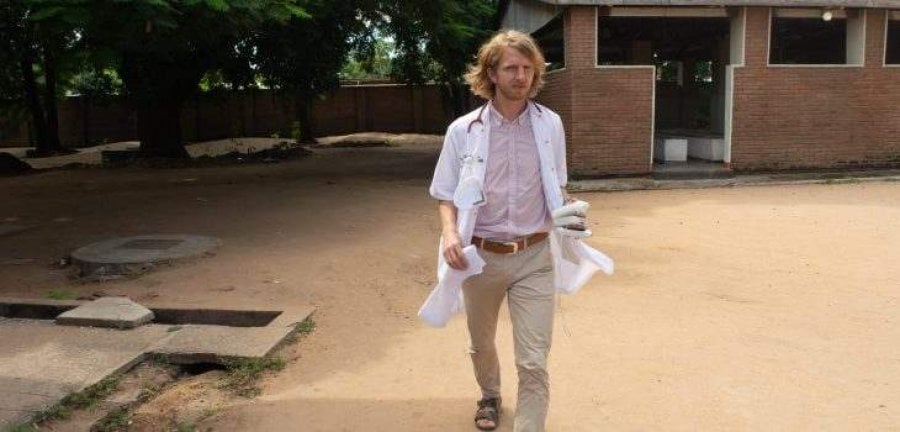COVID-19 Alumni Stories: Thijs Feuth
9 September 2020 London School of Hygiene & Tropical Medicine London School of Hygiene & Tropical Medicine https://lshtm.ac.uk/themes/custom/lshtm/images/lshtm-logo-black.png
How has the COVID-19 outbreak affected your work?
From the beginning in January 2020, when COVID-19 cases started being recognised outside of Wuhan, we began planning and discussing in our hospital about what would happen if it came to Europe. It was important that we remained engaged with the situation in China. When COVID-19 eventually came to Europe, in that first month in our hospital, we were seeing very few cases and a lot of regular patients were not coming to the hospital because we had decided to do telephone calls to non-urgent patients instead of seeing them face to face. Although the government placed restrictions to reduce the R0, we still expected many cases because we did not know how effective these restrictions would be. However, quite soon it became clear that we were not seeing a large number of cases as other countries and so after some weeks we could start to see non-urgent patients and transition back to normal clinical work.
How have you been responding to the outbreak?
Our hospital does symptomatic testing for suspected COVID-19 cases and although in the beginning there was a shortage of tests, presently we are testing quite a lot. With the first cases we saw, there was still much uncertainty about COVID-19 treatment and prognosis. There was a lot of fear among patients because the focus in the news was on COVID-19 related mortality. We had to be clear in communicating to patients that even though people were dying, still the vast majority of people were surviving. It was difficult to see the fear in patients who were being admitted for shortness of breath, afraid of ICU admission and at the same time not being able to see their family, at the moment that they needed them the most. Those first days for me were quite emotional but of course we tried not to show that to patients, we tried to show confidence.
During that time, I also had some different research projects going on. One was a study gathering real time clinical data on COVID-19 cases and providing updates twice per week. Another one was a survey focused on health care workers in the pulmonology department and their feelings about the COVID-19 pandemic. We are not so used to being open about our emotions in Finland, it is the culture here to keep feelings, especially the bad ones, to yourself. However, we were getting signals that the situation was really very heavy for everyone, and we wanted to create an environment where people could talk about their worries. The survey first addressed what positive feelings health workers might have about the pandemic e.g. do people feel grateful to be a part of the efforts against this disease, do they have positive feelings about themselves? Then it addressed what worries and concerns they had about the pandemic e.g. were they worried about their own health, or the health of their loved ones, or the country?
There were also open questions that allowed respondents to bring up any other concerns, and we received many answers to that, such as uncertainty about the future, worry about PPE resources to protect themselves, the worry about living alone during this crisis. But there were also a lot of comments on how people were dealing with these feelings, for example going out into nature, taking a walk and taking time for self-care. This survey was quite useful, from the respondents we received a lot of feedback that it was very good that we had opened up this discussion.
How has your country’s response to the outbreak affected your work?
In Finland, we haven’t had as large of an outbreak. The virus arrived in Finland a bit later than the UK, and by that time we were already having political engagement going on, so the response was efficient. Instead of dealing with an epidemic, we had the kind of prevention of an epidemic.
One thing that has been interesting to see is how the general public has now received an education on epidemiology and virology. They have gotten a lot of information through the media. Not everyone can understand it in the right way but I think it’s quite great to see everyone engaged in this way.
How has LSHTM’s training helped you during this outbreak?
LSHTM‘s training has been quite useful, especially as outbreak recognition was part of my course. For example, one year ago there was an outbreak of invasive pneumococcal disease in shipyards in Turku, Finland. Because I had been at LSHTM, I was very focused on identifying early on that there was an outbreak and that we needed to act. Similarly, with COVID-19, very early on when the only cases were in Wuhan I was quite engaged with the reports, alerting our pulmonology department to what was happing in Wuhan and putting it on the agenda for discussion. In those early days we were already discussing what could happen if the outbreak reached Europe, how would we act and how we would prepare. The LSHTM alumni network has also been very helpful. The DTM&H WhatsApp group has really been useful in getting information about the pandemic from alumni around the world. Aside from relying on the news, publications in the medical literature and bulletins from the WHO, it was good to get information that helped us all at the beginning of the pandemic to understand what was happening worldwide.